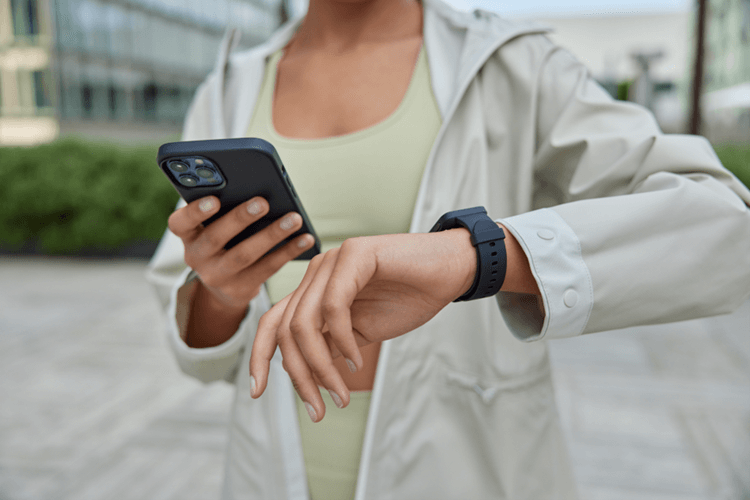
“Digital health encompasses the use of technology and data to improve healthcare delivery, patient outcomes, and overall well-being.” – ChatGPT
Welcome to the Current Global series on digital health. Here we’ll explore this fast-evolving field and dive into topics like artificial intelligence (AI) in healthcare, accessibility, ethics, and more. Whether you’re headed to CES 2024 or JPM this week to learn about the future of health tech from the experts, or just want a recap of the basics, we’re here to help. So, grab a coffee, turn on do not disturb while Alexa fires up your AI-curated playlist, and take a moment to explore digital health with us.
***
First, definitions: Digital health is a broad term that encompasses a plethora of technologies – and it’s quickly evolving. These technologies include things like wearables (Apple Watches and Fitbits); telemedicine; robotic surgery; patient portals; diet, exercise, and meditation apps; electronic medical records; and much more. That extremely intelligent robot performing heart surgery and the free app that teaches you breathing techniques are both under the umbrella of digital health.
Now, here are five of the basics you need to know about digital health in 2024.
1. The FDA is essential in ensuring the safety of some but not all new digital health tools.
Many new digital health tools, from hospital software to robotic surgeons, must be submitted to the FDA for approval to ensure that the benefits of the tool outweigh its risks. However, some low-risk technologies like wellness apps, are not required to be approved by the FDA. The FDA’s Digital Health Center of Excellence has the goal of “empowering stakeholders to advance health care by fostering responsible and high-quality digital health innovation.” To help digital tool evaluators in this process, the FDA announced last year the creation of its Digital Health Advisory Committee to help explore and advise on issues related to digital health technology. This committee should be fully operational in 2024 and will begin to provide advice and recommendations on new approaches to evaluate the benefits and risks of digital health technologies.
2. Digital health strategies are typically a more environmentally sustainable option.
By implementing digital health strategies, the healthcare system can reduce its carbon footprint, provide more convenient and proactive care, and enable the introduction of new technologies. For example, telehealth services eliminate the need to travel for patients and providers, resulting in fewer vehicle emissions.1 The use of electronic medical records (EMRs) is another example that generally makes digital tools a more sustainable option. That said, while reducing paper use is environmentally friendly, there are other variables to consider. For instance, the energy required to run the digital tool, as well as the materials to create the technology, may partly offset the energy and resources it saves.2 It’s important to keep in mind that there’s always a balance.
3. Digital health can streamline communication and care with healthcare providers.
By providing physicians and patients with a convenient and nearly instant way to communicate, care can be simpler and even more proactive. For instance, through an online portal patients can receive their treatment plans and quickly respond to their health care provider with questions or concerns. These services keep the patient informed and have resulted in increased patient engagement.3 In addition to patient portals, EMRs can also be used to increase proactive care.4 Keeping all healthcare-related information in a shareable, electronic form allows physicians to access information from a patient’s previous providers, giving a more holistic view of the patient prior to treatment. And more knowledge allows for a more efficient diagnosis and treatment plan.
4. Accessibility is improving, but it still has a way to go.
While tools like telehealth appointments may make healthcare more accessible for some (for instance, those who have difficulty traveling), some patients may be left behind. Those who are not technologically literate, lack access to the internet or new technologies, or use assistive technologies may be at a disadvantage. For example, a visually impaired person using a screen reader may not be able to access or respond to information from their healthcare team, schedule appointments, or provide informed consent while maintaining privacy. Likewise, patients who are deaf or hard of hearing may struggle to utilize telehealth visit options because the telehealth platform may not support captioning or sign language interpretation. Digital health tools and apps should always be designed to ensure that their technology is compatible with accessibility tools.
5. As with any new technology, there are ethical implications.
Because digital health tools are evolving so quickly, we don’t always have much time to reflect on their ethical issues. For example, if a highly specialized robot makes a mistake during surgery, who is at fault? The robot? The physician overseeing the operation? The engineer who designed the robot? The company that produced the robot? In addition to robotic surgeons, large language models (LLM) like ChatGPT are being introduced to the healthcare system and can quickly outpace regulatory oversight. We need to think about the ethical implications of these technologies (and put guidelines in place) before their broad integration into our healthcare systems.
***
At Current Global, digital health is a critical part of the work we do for our clients. From biopharmaceuticals to health tech to managed care, we bring innovative ideas and expertise to every client for every project. To learn more about how we might support your organization, feel free to get in touch at hello@currentglobal.com.
Here’s to a fruitful time for those among us at JPM and CES this week!
***
References
We thrive on solving the toughest business and brand challenges. We’d love to discuss how we can help you ignite your spark.
hello@currentglobal.com